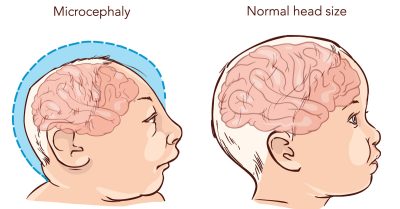Study Shows Anti-mosquito Pesticide Pyriproxyfen Link with Microcephaly
Five years ago, GMWatch was correct to draw attention to dangers of the chemical.

All Global Research articles can be read in 51 languages by activating the “Translate Website” drop down menu on the top banner of our home page (Desktop version).
Visit and follow us on Instagram at @crg_globalresearch.
***
A recently published study shows that the common pesticide pyriproxyfen could exacerbate the already severe effects that the Zika virus can have on brain development. The researchers found that pyriproxyfen impairs thyroid hormone signalling in the brain, modifying crucial processes for its proper development (more details below). The findings confirm hypotheses that GMWatch focused attention on five years ago – and was severely attacked for doing so.
GMWatch vindicated: You (probably) read it here first
Back in 2016, fear of the Zika virus as a potential cause of the birth defect microcephaly was at its height. An outbreak of microcephaly, in which babies are born with small heads and brains, had occurred in Brazil’s northeast, and Zika was being blamed as the sole cause.
But we at GMWatch noticed that evidence identifying the virus as a sole cause of the microcephaly cases was scant and unconvincing. We also noticed an increasing number of reports from South America suggesting that another hitherto overlooked potential cause of the outbreak. According to the Argentine doctors’ organisation, Physicians in the Crop-Sprayed Towns (PCST), in the area where most of the affected people lived, a chemical larvicide aimed at eradicating disease-carrying mosquitoes was introduced into the drinking water supply in 2014, in a state-controlled programme to control the dengue and Zika viruses. This pesticide was known to produce malformations in mosquitoes, and PCST asked if it could do the same in humans.
The Brazilian doctors’ and public health researchers’ organisation, Abrasco, also named the pesticide as a possible factor (among others) in the microcephaly outbreak.
Vicious and irrational attacks
We began to draw attention to the pyriproxyfen link, publishing several articles on the topic. Our articles unleashed a deluge of vicious and often irrational attacks from pesticide defenders, which were among the most extreme we’ve experienced.
The defenders of pyriproxyfen included “experts” invoked by the Science Media Centre of Australia, who, in a seeming determination to exempt the pesticide from blame, followed the usual pro-pesticide and pro-GMO agenda of the different global branches of that organisation. This is not surprising given that current and past funders of the Science Media Centre UK include pesticide companies Bayer, BASF, Monsanto, and Syngenta.
While the new research shows that GMWatch was correct to draw attention to the now proven dangers of pyriproxyfen, it is shameful that the pro-pesticide “shouting brigade” were more concerned with defending this risky chemical than investigating a public health scandal that has resulted in permanent harm to the victims.
The new research
For their experiment, the researchers used genetically modified tadpoles that emit green fluorescence when exposed to thyroid hormone. More thyroid hormone means more green signal, showing that the hormone is active in the tadpoles’ cells.
When they exposed the tadpoles to pyriproxyfen, the green signal dropped dramatically. This showed that the pesticide blocks thyroid hormone action. One of the roles of thyroid hormone, two of the study’s authors explain in an article for The Conversation, is to generate a balanced amount of nerve cells and their supporting cells, known as glia, which together form the essential building blocks of the brain.
Since pyriproxyfen blocks normal thyroid hormone action, the researchers thought it might also affect the generation of neurons (nerve cells) and glial cells. To investigate this, they exposed stem cells cultured from mouse brains to increasing doses of pyriproxyfen.
The findings were clear: The higher the dose, the fewer cells were generated, and the more they died, producing an unbalanced proportion of nerve cells and glia.
The brains of the exposed tadpoles did not develop normally, making them behave unnaturally. Underlying these changes were altered expression patterns of a number of genes. The researchers infected exposed stem cells with the Zika virus and found that the transcription of key genes was altered compared to when they were infected with the virus alone and not exposed to the pesticide. Although they didn’t observe higher Zika infection rates, the authors suggest that the pesticide exposure could aggravate hampered brain development. That can worsen the impact the virus has on a child’s later-life intellectual capacities.
Zika and COVID-19
There is a striking parallel between the chorus of condemnation that was so keen to shout us down when we originally suggested that anything other than the Zika virus might be contributing to the unexpected outbreak of microcephaly birth defects, and the chorus of condemnation that greeted us when we started to draw attention to the lab leak hypothesis in relation to the virus behind the current pandemic. In both cases, these choruses were led largely by those with strong vested interests who were keen to invoke a supposed scientific consensus – before the evidence was remotely in – as a way of suppressing an exploration of alternative hypotheses.
A group of scientists recently wrote a letter to The Lancet, entitled An appeal for an objective, open, and transparent scientific debate about the origin of SARS-CoV-2. They stated: “We do not think that scientists should promote ‘unity’… science embraces alternative hypotheses, contradictory arguments, verification, refutability, and controversy. Departing from this principle risks establishing dogmas, abandoning the essence of science, and, even worse, paving the way for conspiracy theories.”
This has proven to be as true of Zika and microcephaly as of the origin of SARS-CoV-2.
*
Note to readers: Please click the share buttons above or below. Follow us on Instagram, @crg_globalresearch. Forward this article to your email lists. Crosspost on your blog site, internet forums. etc.

